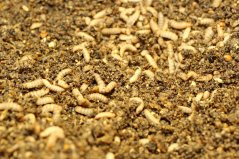
Project
Valuing waste streams, towards a digital twin
In this project we explore how a Digital Twin can contribute to decision making regarding crop biomass allocation in regions with smallholder farming systems, aimed at optimizing the use of agricultural waste streams. The aim is to first have a model-based scenario evaluation, and based on this define a set of requirements for a digital twin.
As case study bio-fertiliser production from crop residues and other organic waste streams is selected. Mineral fertilizer use in Uganda is notoriously low – expensive, and resentment among farmers to use “chemicals”. Due to continuous cultivation with limited use of any inputs, soils are depleting. Some crop residues/ manure is used, but still too little to compensate nutrient offtake (or e.g. accumulation on certain fields, but depletion on others). Farmers would benefit from improved use/ increased availability of organic fertilizer.

To move into recycling of waste black soldier fly larvae are a promising option to treat the waste streams. However, many waste streams are used already! And: to produce good & consistent quality bio-fertilizer there needs to be a constant supply over the year, from diverse sources, with more or less the same composition. Bio-fertilizer companies would benefit from real-time information on availability of waste streams throughout the year.
In the scenario evaluation we will develop models to support decisions related to for example logistics (where to place facilities, central or decentral model, which company is best placed where), sourcing of additional waste streams, quality versus costs of bio-fertilizer output, and consistency in relation to (seasonal) availability of additional waste streams are likely to play a role in this process.